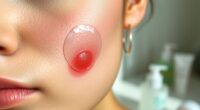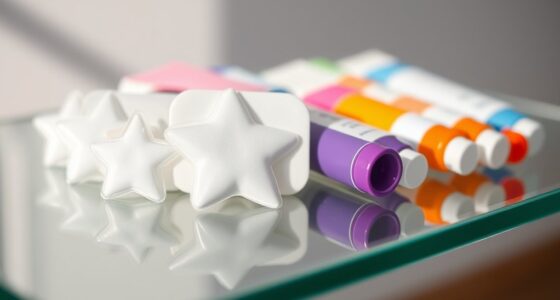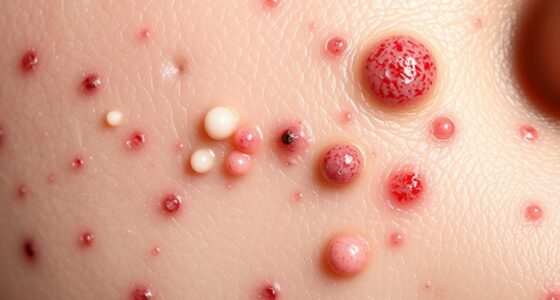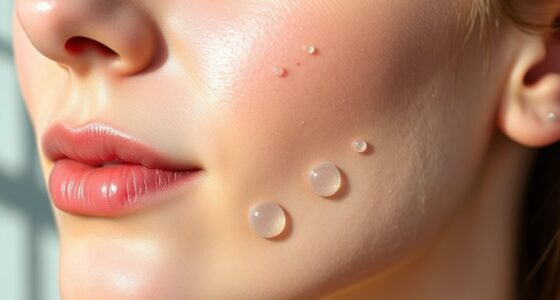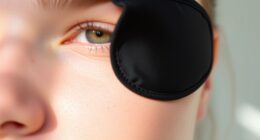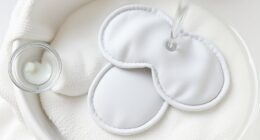Humidity makes acne patches less effective by adding moisture to your skin, which weakens the adhesive and causes the patches to loosen or fall off early. To fix this, dry your skin thoroughly before application, use oil-free and matte primers, and choose waterproof patches. Gently press down on the edges to ensure a tight seal and avoid touching or repositioning the patch. Keep these tips in mind to improve adhesion and see better results—there’s more to discover below.
Key Takeaways
- Humidity increases skin moisture, creating a barrier that weakens the patch’s adhesive, causing it to peel or lift.
- Moisture makes skin slicker, making patches slide off or detach easily in humid conditions.
- Proper skin prep, including cleaning and drying, improves patch adhesion in humid weather.
- Using patches with waterproof or stronger adhesives enhances sticking during high humidity.
- Applying a matte-finish primer or oil-free moisturizer helps create a barrier against moisture transfer.
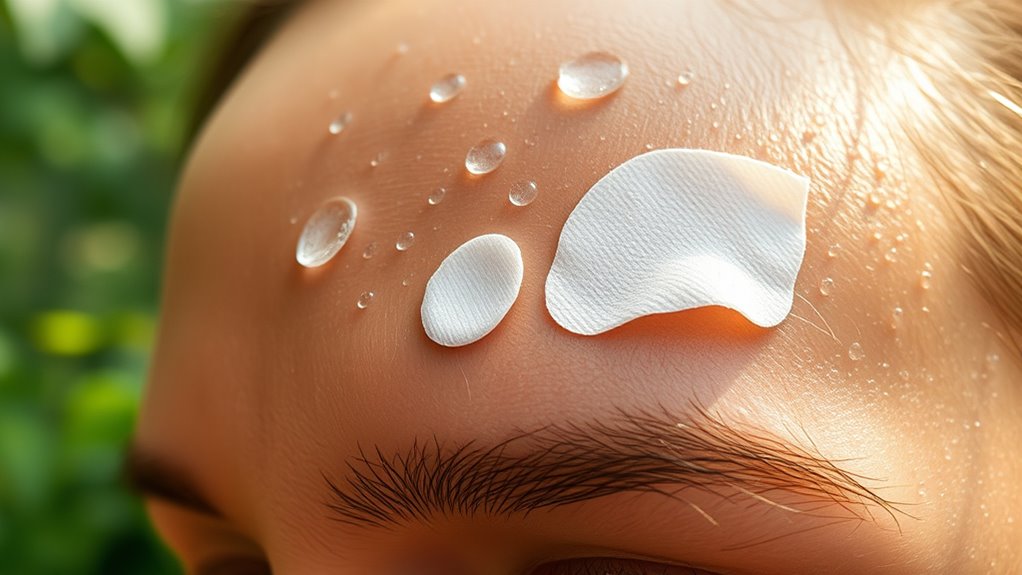
Have you ever wondered how effective your acne patches are when the weather turns humid? Humidity can be a real challenge for these tiny skin protectors, often causing them to peel off prematurely. The main issue behind this is moisture absorption. When the air is damp, your skin’s surface becomes more hydrated, which can interfere with the adhesive’s ability to stick properly. Acne patches are designed to adhere to dry, clean skin, but in humid conditions, excess moisture creates a barrier between the patch and your skin. This barrier weakens the adhesive, leading to adhesive failure and causing the patch to lift or fall off altogether.
Moisture absorption isn’t just a matter of discomfort; it directly impacts how well your acne patch stays in place. When your skin absorbs moisture from the humid air, it becomes slicker and more prone to sliding out of the patch’s grip. The adhesive on these patches is formulated to work under normal conditions, but it struggles when faced with increased moisture. The result is often a patch that feels loose, or worse, completely detached before it can deliver its treatment. If you’re battling humidity regularly, you might notice your patches don’t last as long or don’t stay put during the day.
Moisture makes acne patches slip and detach, reducing their effectiveness in humid conditions.
To combat this, you need strategies that minimize moisture absorption and support better adhesion. First, ensure your skin is thoroughly clean and dry before applying the patch. Use a gentle, alcohol-free toner or a matte-finish primer to remove excess oil and moisture from your skin’s surface. This helps create a less humid environment for the patch to cling to. Additionally, consider applying a light, oil-free, and mattifying moisturizer beforehand, but make sure it’s fully absorbed before sticking the patch on. This step can help create a barrier that reduces moisture transfer, improving adhesive strength.
Another practical tip is to choose patches with stronger adhesives designed to withstand humidity. Some brands offer waterproof or sweat-proof options that are better suited for humid climates. After applying the patch, gently press down on its edges to ensure it forms a tight seal, reducing the chance of air and moisture sneaking underneath. If you’re outdoors or in high humidity situations, try to avoid touching or repositioning the patch as much as possible, as this can disturb the adhesive’s grip.
Ultimately, understanding how moisture absorption affects adhesive performance helps you take proactive steps to keep your acne patches in place. Proper skin prep, selecting the right patch, and sealing the edges can make a big difference. With these adjustments, you’ll improve the longevity and effectiveness of your acne treatment, even in the most humid weather. Understanding the impact of environmental factors is crucial for optimizing skin treatments in humid conditions.
Frequently Asked Questions
Can Humidity Cause Skin to Become More Oily?
Yes, humidity can cause your skin to become more oily. When the air is humid, your skin increases oil production to maintain proper skin hydration. This extra oil can make your skin feel greasy and lead to breakouts. To manage this, wash your face regularly and use products designed for oily skin. Staying consistent helps balance oil levels and keeps your skin healthier, even in humid weather.
Are Certain Acne Patches Better for Humid Environments?
Imagine your skin is a fortress, and moisture barriers are its sturdy walls. In humid weather, some patches struggle to stay, like fragile bridges in a storm. Look for acne patches with strong patch consistency that adapt to moisture. These patches work better in humid environments because they grip tighter, resisting slipping. Choosing the right patch helps you maintain your skin’s defenses, even when humidity tries to breach your barrier.
How Long Should I Wait Before Applying a New Patch?
You should wait at least a few hours before applying a new patch after removing the previous one. Proper skin preparation is key—clean your skin thoroughly and dry it well to guarantee the patch sticks properly. When selecting a patch, choose one suited for humid conditions, like hydrocolloid types. This approach helps improve adhesion and maximizes effectiveness, especially in challenging weather.
Does Sweating Affect the Adhesion of Acne Patches?
Sweating can definitely interfere with patch adhesion, especially during intense activity or hot weather. When you sweat, moisture builds up on your skin, causing the patch to loosen or fall off. To avoid sweat interference, make sure your skin is dry before applying the patch, and consider using a gentle powder to absorb excess moisture. Proper skin prep helps make sure your acne patch stays securely in place and works effectively.
Are There Specific Ingredients That Help Patches Stick Longer?
Think of the adhesive formula as the secret handshake that keeps your patch in place. Certain ingredients, like silicone-based adhesives or medical-grade acrylics, enhance ingredient longevity and help patches stick longer. Look for products with these components, as they create a stronger bond, especially in humid weather. Using a clean, dry skin surface also boosts adhesion, turning your patch from a fleeting visitor to a steadfast protector.
Conclusion
So, next time your acne patch decides to take a vacation in humid weather, remember it’s not giving up on you—it’s just auditioning for a role in “Slip-and-Slide.” Instead of losing your cool, try prepping your skin better, choosing waterproof patches, or waiting for the rain to clear. Who knew fighting acne would require a weather forecast? Stay dry, stay sticky, and maybe invest in a fan—your skin’s new best friend.

